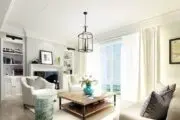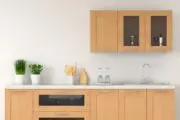Several of the hottest interior design trends for 2024 are converging in the kitchen, where color, mixing metals, curved lines and a renewed energy for self-expression are the inspiration for some spectacular design elements. Notably, all these trends are combining to fuel the evolution of the statement range hood, which has always been highly functional, but until recently, not particularly fashionable.
A necessity in a kitchen to wick away aromas, grease and gases that come with indoor cooking, the range hood has essentially been cast in a supporting role in kitchens. For years, a range hood was a sleek, small column over the stove, or integrated in an over-stove light, or microwave.
“We had hood blindness”, says Bill Cook, director of communications at metalsmith company Thompson where the design goal was invisibility, or at least minimal intrusion on the overall design. “For many years in the industry, we almost didn’t see range hoods,” he says.
But in today’s kitchen, the range hood is embraced, as opposed to avoided. “You don’t have to hide ventilation. It’s not this scary word that serves a functional purpose, but also can be this gorgeous expression of your design aesthetic,” he says.
With the door open wide for homeowners to express themselves in the kitchen, the statement range hood is taking center stage- literally as a bespoke, beautiful focal point.
Why are statement range hoods trending?
The kitchen is at its core, a functional space, but homeowners are investing in the heart of emotionally as well as financially.
“A gorgeous kitchen is kind of the ultimate luxury,” says Cook. “Everybody needs a space to cook, but when you can make it beautiful, in a place where you spend a lot of your time, having that sort of beautiful space that is aspirational and inspirational.”
A statement range hood leverages that concept uniquely. From gentle curves to bold, angular shapes, with a wide range of finishes, materials and accessories to choose from, homeowners can really make their mark with a statement range hood, tapping into the current enthusiasm for self-expression in interior design.
It’s a deeply personal design element, much like a work of art, but with a functional layer. A statement range hood also serves as a visual touchstone for homeowners that signals a transition from the ordinary to luxe and special, reinforced when they enter the space daily.
For homeowners with a builder-grade range hood, or with a range hood tucked away in cabinetry or a microwave, if you are DIY-inclined, creating a statement range hood is a reasonable project. Alternatively, at the construction phase, or during a kitchen remodel, a statement range hood can be constructed as an intentional focal point right from the start.
A statement range hood is also the perfect canvas to take advantage of mixing metals, a trend taking kitchens by storm. One of the guiding principles of mixing metal strategy is to pick a dominant metal to occupy the bulk of the aesthetic space, and then build accents out in a complementary or contrasting metallic tone. Given the visual weight of a range hood proportionate to the rest of the kitchen, it’s the right spot for that dominant metal choice.
With all the options available, where should you start? Here are some suggestions and inspiration to design a statement range hood.
Function first
Although a statement range hood plays an important aesthetic role in kitchen design, it is critical to remember that a range hood is function first.
Gases, odors and grease that inevitably come from cooking not only make a mess in the kitchen, over time they accumulate in wall coverings, window coverings, furniture upholstery and more.
- That means you need a range hood of adequate size and power to direct gas, odor, grease away. As a general guideline, the power of the range hood (i.e. the fans) should match the capacity and heat production of the cooktop below.
- Ductwork will impact its efficiency, so discuss that with your builder or designer to make sure the configuration and type of ducting is appropriate for the range hood’s placement, style and size.
- Size matters. Your range hood should be around the size of your cooktop, and sometimes a few inches larger, but no more than that.
- Make sure your range hood works with your ceiling height, both aesthetically and physically. Certain shapes and finishes can make your kitchen appear more spacious.
- Range hood fans are hardworking and can be very noisy. Consider how much noise will be produced with a particular hood range while in use, and how that might impact on your experience in the kitchen and surrounding areas.
Determine your style
The sky’s the limit when it comes to creating a statement range hood, especially if you are considering a custom design and finishes.
Start by determining your style objectives, according to Cook.
“It (a range hood) can be a dramatic statement piece that completely stands out and is contrasting to your cabinetry and to your surfaces, or it can play a supporting role, where it’s still this beautiful, handcrafted piece that gets attention, but seamlessly integrates into the space without capturing all the visual attention,” he says.
Not only is size a major criterion for your range hood’s functionality, but it also matters for aesthetics too. It should be proportionate; the key is to make a statement, without overwhelming the space.
Many homeowners choose to frame in their hood fan and cover it with materials they desire.
Some trending statement range hood ideas include:
- Beadboard
- Wood, including reeded wood and natural wood
- Tile, similar to the backsplash
- Plaster
- Paint
- All kinds of metals, including steel, brass, copper, nickel gold and matte black with a variety of textured finishes
- If you don’t want to commit to a full range hood makeover, consider applying trim, which is an effective way to elevate the look — wood and metallics are popular trim choices
A statement range hood is a great place to take design risks, but Cook reminds homeowners to strike a balance when customizing their range hood. “Find or create a design that you can live with every day right,” while still being unique, he says.
“Don’t be afraid to take risks and if you want this to be the focal point, just like a piece of art or sculpture, it should meet your taste,” he says.










